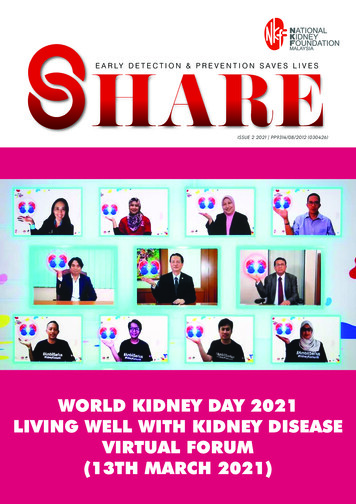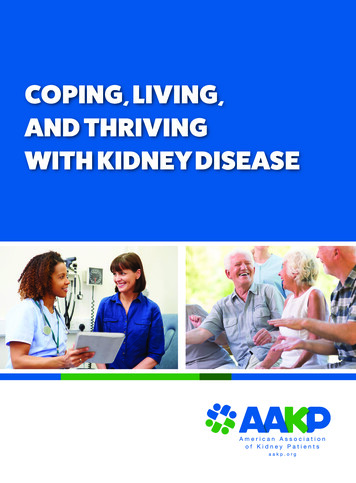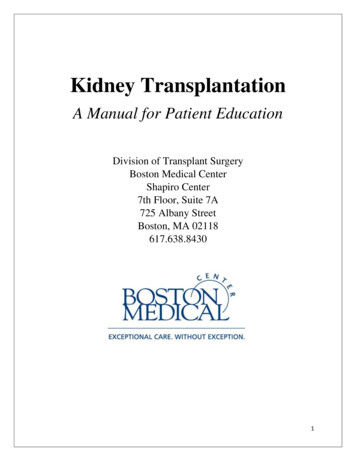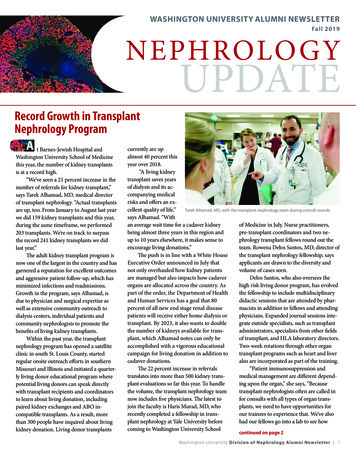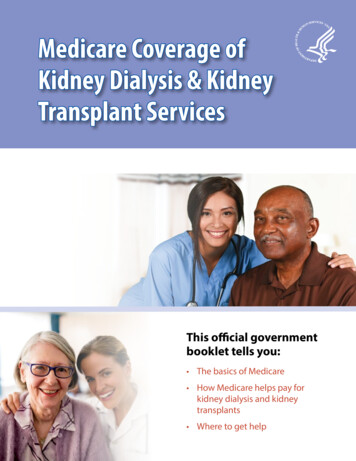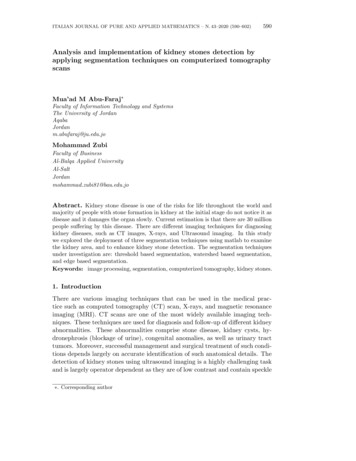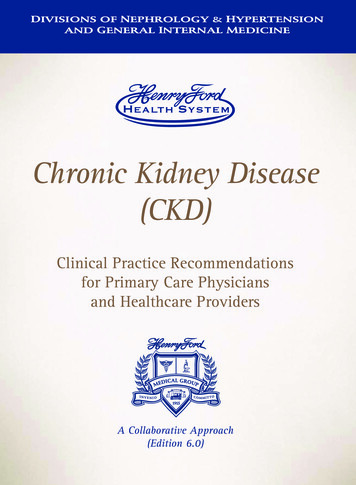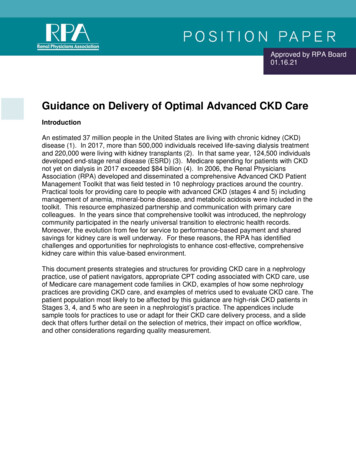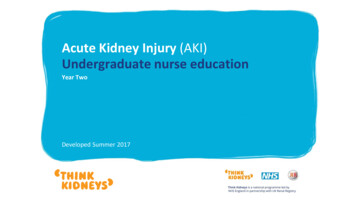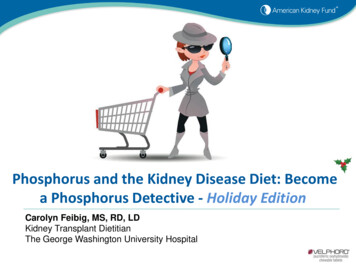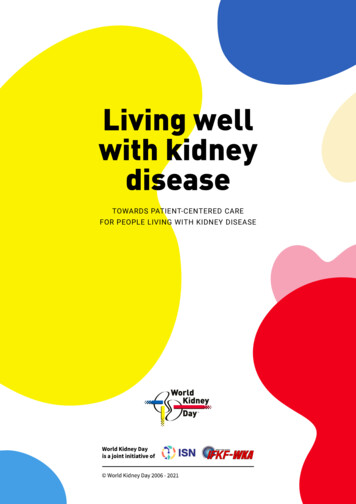
Transcription
Living wellwith kidneydiseaseTOWARDS PATIENT-CENTERED CAREFOR PEOPLE LIVING WITH KIDNEY DISEASE
Chronic Kidney Disease (CKD), its associated symptoms,and its treatment - including medications, dietary andfluid restrictions, and kidney replacement therapy - candisrupt and constrain daily living and impair the quality of life ofpatients and their family members including treatmentsatisfaction and clinical outcomes. There is an increasingrecognition of the need to identify and address patient priorities,values and goals in order to advance research, practice andpolicy which improve the quality of life of people with CKD.(World Kidney Day, 2020) Regardless of the type of kidneydisease or treatment stage, patients want to be able to live well,maintain their role and social functioning, protect somesemblance of normality, and have a sense of control over theirhealth and wellbeing. (World Kidney Day, 2020) With healthprofessionals consistently giving higher priority to mortality andhospitalization, and patients prioritizing those outcomes whichimpact their life, such as the ability to travel, advancingeducation, engagement and shared decision-making is vital.(Banerjee, et al., 2020)28
Insufficient education about treatment affects patient choice35% of patients with pre-end stage kidneyof therapy and levels of satisfaction, e.g. patients on a homedisease (ESKD) had no knowledge of anytreatment modalities post kidney failuretherapy or with a kidney transplant were found to be more1satisfied than those with in-center hemodialysis (ICHD)Only 58% of the participants in a recent survey2reported existing patient involvement in clinicalPatients least involved with their care have 8% to21% higher health costs, than patients with thetrials in nephrologyhighest level of activation3Non-adherence rates to dialysis among CKDAbout 2/3 of care-partners of hemodialysispatients can range from 2% to 98% and is linkedpatients reported that their mental health andamong other to contributing factors (e.g. sideeffects) reducing the quality of life1(Finkelstein, et al., 2008)24vitality was affected by 1.7-1.8 points on the5Caregiver Burden scale (ranging 1 to 4)(Fadem, et al., 2011)3(Banerjee, et al., 2020)46(Hibbard, et al., 2013); ‘Patient activation'describes the knowledge, skills and confidence a person has in managing their own health and care. (National Health Service (NHS)England, n.d.)5(Chironda & Bhengu, 2016)6(Belasco & Sesso, 2002)38
Policy landscapeand changePatient-centeredness —the idea that care should be designed aroundpatients’ needs, preferences, circumstances, and well-being— is a centraltenet of health care delivery. (Cosgrove, et al., 2013) The World HealthOrganization (WHO) defines empowerment as “a process through whichpeople gain greater control over decisions and actions affecting theirhealth” and should be seen as both an individual and a community process.(World Health Organization , 1998) Four components have been reportedas being fundamental to the process of patient empowerment: 1)understanding by the patient of his/her role; 2) aquisition by patients ofsufficient knowledge to be able to engage with their healthcare provider; 3)patient skills; and 4) the presence of a facilitating environment. Based onthese four components, empowerment can be defined as:A process in which patients understand theirrole, are given the knowledge and skills bytheir health-care provider to perform a task inan environment that recognizes communityand cultural differences and encouragespatient participation.- World Health Organization · 2009 -48
The most recent United Nations (UN) politicaldeclarations on Universal Health Coverage (UHC) andNon-communicable Diseases (NCDs) subscribe to thepromotion of patient-centered health systems, for empoweringpatients, giving them access to their own healthcareinformation, promoting health literacy and strengthening patientinvolvement in clinical decision-making with a focus on healthprofessional-patient communication (United Nations GeneralAssembly , 2019), §65), (also §35, (United Nations GeneralAssembly, 2018)).A broader multidimensional framework is needed for thedevelopment of interventions and policies that support patientengagement on various levels - clinicians, administrators,members of professional societies, researchers as well as policymakers. (Carman, et al., 2013)58
Continuum of engagementLevels ofengagementConsultationInvolvementPartnership andshared leadershipDirect carePatients receiveinformation about adiagnosisPatients are asked abouttheir preferences intratment planTreatment decisions are madebased on patients’preferences, medical evidence,and clinical judgmentOrganizational designand governanceOrganization surveyspatients about their careexperiencesHospital involves patientsas advisers or advisorycouncil membersPatients co-lead hospitalsafety and qualityimprovement committeesPolicy makingPublic agency conducts focusgroups with patients to askopinions about a health careissuePatients’ recommandationsabout research priorities areused by public to make fundingdecisionsPatients have equal representationon agency committee that makesdecisions about how to allocateresources to health programsFactors influencing engagement:Patient (beliefs about patient role, health literacy,education)Organization (policies and practices, culture)Source: Carmen, et. al., 2013Yet engagement is not a quick fix. Many patients and clinicians are still operating in an older paradigm of apaternalistic clinician and system. Efforts need to be made not only to raise patients’ awareness about the benefits ofengagement but also to encourage and support their increasing responsibility and leadership. (Carman, et al., 2013)Concrete actions to further patient-centeredcare for people living with kidney disease01Empower patients to understand their role and have theknowledge, and confidence, to be able to engage withclinicians in shared decision-making, and supportselfmanagement02Strengthen partnerships with patients and their care-partnersin the development, implementation and evaluation ofinterventions, in both practice and policy settings, that enablepatients to live well with kidney diseases03Develop and implement validated patient-reported outcomemeasures – monitored/ supported by regulatory agencies as a metric for quality care to assess and address areas of lifeparticipation in routine care04Funding agencies should establish targeted calls for researchthat address the priorities of patients05Prevent or treat, as early as possible, the symptoms, sideeffects and psychological, social and spiritual problemsrelated to kidney disease and/or its treatment06Promote self-management programs, cognitive behavioraltherapy and group therapies for managing depression,anxiety and insomnia6807Increase resources for, and access to, comprehensivehealthcare provision to address patient wellness includingdrugs, nutrition and rehabilitation services08Promote home dialysis therapies in combination withappropriate ‘assisted’ dialysis programs, in order to reduceboth patient and care partner fatigue and burnout.09Push for bespoke care guidelines for vulnerable anddisadvantaged populations10Involve primary care and general physicians, especially in lowand low and middle income countries (LICs and LMICs), toimprove the affordability and access to services through thepublic sector by helping patients with CKD to managesymptoms and improve wellness11Provide additional structural support - such as communityoutreach, education, telemedicine, and collaboration withfaith-based community leaders – in LMICs to lendpsychological support and help build trust within the healthcare system and providers
Global practicesThe International Society of Nephrology charged theresearch community with enrolling 30% of CKD patients by2030. (ASN, et al., 2019). A call to action further cementedby the ISNACT project recently issuing a statement onincluding people with kidney disease in COVID-19 trials(International Society of Nephrology (ISN), 2020).www.theisn.orgThe Standardised Outcomes in Nephrology (SONG)initiative aims to establish a set of core outcomes andoutcome measures, for trials and other forms of research,across the spectrum of kidney disease. These outcomeswill be based on the shared priorities of patients,caregivers, clinicians, researchers, policy makers, andrelevant stakeholders. This will help to ensure thatresearch is reporting outcomes that are meaningful andrelevant to patients with kidney disease, their family, andtheir clinicians; to support decisions about treatment.www.songinitiative.orgCan-SOLVE CKD is a pan-Canadian patient-oriented kidneyresearch network. In partnership with patients,researchers, health care providers, and policy-makers, it isworking to transform treatment and care for Canadiansliving with or at risk for chronic kidney disease.www.cansolveckd.caThe Kidney Health Initiative (KHI) promotes inter alia thestudy of patient preferences for innovative renalreplacement therapy (RRT) devices in its TechnologyRoadmap for Innovative Approaches to Renal ReplacementTherapy (Kidney Health Initiative, 2019).www.khi.asn-online.orgHolidays away can be out of reach if you’re on dialysis.Kidney Health Australia offers free haemodialysis servicesto holiday-makers impacted by kidney disease, thanks tothe Big Red Kidney busWorld Kidney Day (WKD) is the global campaign that aims at increasingawareness of the importance of our kidneys to our health and reduces theimpact of kidney disease and its associated problems worldwide. WKD is ajoint initiative of the International Society of Nephrology and theInternational Federation of Kidney Foundations that was started in 2006and has not stopped growing ever eyday.orgThis publication is co-signed by:RIPLARIÑÓN DE PLATA Asociación Civil78
ReferencesBanerjee, D. et al., 2020. International perspectives on patient involvement in clinical trials in nephrology. KidneyInternational, 09 July .Fadem, S. Z. et al., 2011. Satisfaction with Renal Replacement Therapy and Education: The AmericanAssociation of Kidney Patients Survey. Clinical Journal of the American Society of Nephrology, 3 March, 6(3).Finkelstein, F. O. et al., 2008. Perceived knowledge among patients cared for by nephrologists about chronickidney disease and end-stage renal disease herapies. Kidney International, 74(9), p. 1178–1184.Hibbard, J. H., Greene, J. & Overton, V., 2013. Patients With Lower Activation Associated With Higher Costs;Delivery Systems Should Know Their Patients’ ‘Scores’. Health Affairs, February, 32(2).National Health Service (NHS) England, n.d. Patient activation. [Online]Available at: ted-selfmanagement/patient-activation/[Accessed 20 January 2021].World Kidney Day, 2020. WKD 21 Theme. [Online]Available at: wkd-theme/ [Accessed 20 January 2021].Chironda, G. & Bhengu, B., 2016. Contributing Factors to Non-Adherence among Chronic Kidney Disease (CKD)Patients: A Systematic Review of Literature. Medical & Clinical Reviews, 2(29).Belasco, A. G. & Sesso, R., 2002. Burden and quality of life of caregivers for hemodialysis patients. AmericanJournal of Kidney Disease, 1 April, 39(4), pp. 805-812.Cosgrove, D. M. et al., 2013. Ten Strategies To Lower Costs, Improve Quality, And Engage Patients: The ViewFrom Leading Health System CEOs. Health Affairs, February, 32(2).World Health Organization , 1998. Health promotion glossary, Geneva: s.n.World Health Organization, 2009. Patient empowerment and health care . In: WHO Guidelines on Hand Hygienein Health Care: First Global Patient Safety Challenge Clean Care Is Safer Care. 2 ed. Geneva: s.n.United Nations General Assembly , 2019. Political Declaration of the High-level Meeting on Universal HealthCoverage “Universal health coverage: moving together to build a healthier world”, New York: United Nations.United Nations General Assembly, 2018. Political declaration of the 3rd High-Level Meeting of the GeneralAssembly on the Prevention and Control of Non-Communicable Diseases: resolution / adopted by the GeneralAssembly, New York: United Nations.Carman, K. L. et al., 2013. Patient And Family Engagement: A Framework For Understanding The Elements AndDeveloping Interventions And Policies. Health Affairs, February, 30(2).Kalantar-Zadeh, K., Li, P. K.-T. & Tong, A., 2021. Living Well with Kidney Disease by Patient and Care-PartnerEmpowerment: Kidney Health for Everyone Everywhere. Kidney International, 1 February.ASN, ERA-EDTA & ISN, 2019. Ress Release: Kidney Patients are Neglected in Clinical Trials. [Online]Available at: ents-are-neglected-inclinical-trials/[Accessed January 2021].International Society of Nephrology (ISN), 2020. International Society of Nephrology - Advancing Clinical Trials(ISN-ACT) Statement on Trials and COVID-1. [Online]Available pdf[Accessed January 2021].Kidney Health Initiative, 2019. KHI Publications. [Online]Available at: https://khi.asnonline.org/uploads/KHI RRTTechnologyRoadmap PatientEdition.pdf[Accessed 2021 January 2021].88
Living well with kidney disease TOWARDS PATIENT-CENTERED CARE FOR PEOPLE LIVING WITH KIDNEY DISEASE. 2 8 . Non-adherence rates to dialysis among CKD patients can range from 2% to 98% and is linked among other to contributing
